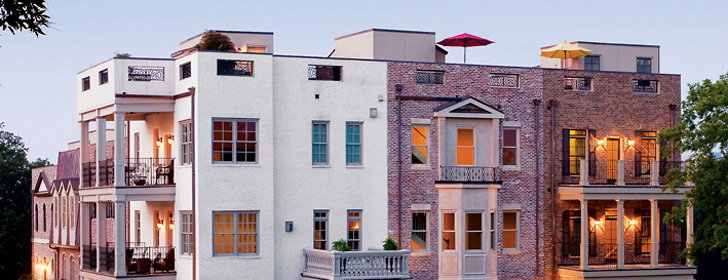A luxury townhouse development blends classic architectural styling with eco-friendly values.
The Acropolis in Nashville has a strangely appealing multiple-personality disorder. One of its six townhouse units has a whitewashed-brick exterior and stone balustrades, typical of the Greek Revival style. The townhouse next door sings of the Federalist era, with rigid up-and-down geometry, detailed entry and traditional shutters. Another unit is prim and proper, with wrought-iron railings, arched transom and mansard roof, evoking the classic English townhouse.
Designed by architect Preston Quirk, principal of Quirk Designs in Nashville, the Acropolis combines five architectural styles in total, from New York brownstone to Georgian-Palladian. Quirk says he was inspired by the famous district of 18th-century townhouses in Savannah, Ga., along Jones Street, where visitors can see nine city blocks of mostly connected townhouses, but never two the same.
"I was just out of school when I lived in Savannah," he says. "What was amazing to me was that each building was so different, yet there was so much harmony with all the different styles together."
The Acropolis €“ so named because it sits high on a hill like the original Greek Acropolis €“ has gained attention not just for its mélange of classic architectural styles; it's also one of the most energy-efficient, sustainable structures in Nashville.
It's one of the very few buildings in the mid-South that's attempting to gain a LEED (Leadership in Energy and Environmental Design) Platinum certification – the highest rating in the LEED program – through the Green Building Certification Institute.
What that means is that while Quirk was fusing together architectural styles for the exterior, the building firm, JBS Custom Builders in Nashville, was worrying about R-values, dumpster capacity and LEED points.
Going "green" for JBS meant far more than adding a few recycled glass tiles, says general partner Brian Glasser. In fact, the Acropolis' green campaign kicked off before the building site was even cleared: In 2007 two houses that needed to be demolished were first picked over by Habitat for Humanity; more than 90 percent of the leftover scraps were then taken to recycling centers.
About 30 dumpsters of waste were filled during the actual construction of the Acropolis, but "we were able to recycle about 98 percent of that," says Glasser.
To help reduce the number of trees needed to build the Acropolis, the walls were built in a truss factory using advanced framing techniques developed by the Forest Products Laboratory in Madison, Wis. These techniques improve the strength of buildings while using much less wood.
The walls were trucked to the building site, and then filled with spray polyurethane foam insulation, which offers tight coverage without the use of harmful solvents or formaldehyde.
Even the mechanics got a green makeover. Instead of specifying a conventional heating and air-conditioning system, the company went with a pricey but high-tech Sanyo ECO-i ductless system that can detect if people are in a room or if a space is getting high, medium or low sun exposure. Instead of a conventional hot-water heater, the builders chose a Rheem instant hot-water heater that brings water up to the desired temperature in less than a second.
Historic hues
For such a special project, JBS Custom Builders paid special attention to the coatings and colors used to finish the units for future homeowners.
For the exterior of unit three, with its Greek Revival€“influenced stone balustrade, JBS chose a cream color from Sherwin-Williams that Nashville designers know as Tennessee Limestone (SW NV5), which was used to cover the exposed brick and give the façade a genteel Southern finish. For the coating product itself, Caroline Harmon, a Sherwin-Williams representative, helped JBS select Sherwin-Williams Duration®Exterior in gloss finish. This self-priming choice offers 50 percent more durability and a 70 percent thicker coat than ordinary house paints. The brick exteriors of other units were left their natural color.
For the interiors of the three finished units, JBS opted for versatile, interesting neutrals such as Whole Wheat (SW 6121) and Macadamia (SW 6142). Harmon's assistance with interior coatings also helped to ensure the project met its LEED requirements. She guided JBS toward Builders Solution®Interior Latex flat.
Though the Acropolis has been a slower sell than its investors had hoped, builder Glasser has no regrets. "Did we make as much money? No. Was it the right thing to do? Yes. Would I do it again? Absolutely."
A touch sell in a tough market
Eco-friendly building is relatively new in Nashville, and not as in-demand as in other cities. Here's how the Acropolis team attempted to sell Nashville natives on the concept:
Traditional styling. No stark modern architecture here. The building sticks with classic architectural motifs such as Greek Revival.
Safe choices. The greenest parts of the Acropolis – mechanicals and the very construction of the walls – are hidden from view. Highly visible choices go back to tried-and-true favorites, such as granite on the kitchen counters.
Smart marketing. Instead of emphasizing green building as a way to save the planet, marketing materials for the Acropolis focus on saving money on energy bills.
Location, location. By placing the develop-¡ment in a busy part of Nashville, just off Centennial Park, the builder gained a selling point and LEED points.







